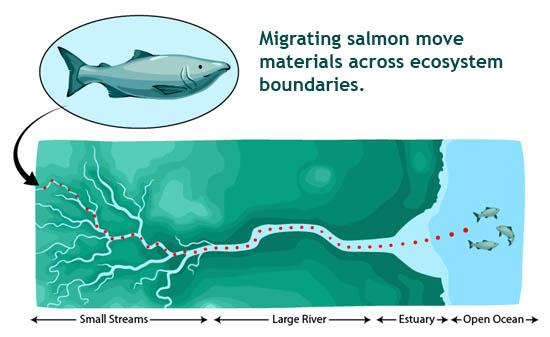How Are Ecosystems Related?
Nutrients, organisms, water, air, and any of the other parts of ecosystems can move in and out of ecosystems. The boundaries that we can draw around an ecosystem aren't solid walls, but instead allow materials to pass across them. For example, in the ecosystem of your mouth, food, oxygen, and water come in from outside the ecosystem, and these materials also leave the mouth ecosystem when you swallow or exhale. Flows of materials into and out of ecosystems cross boundaries between ecosystems and connect them together.
Let's see an example of how many ecosystems can be connected. Salmon, a type of fish, are amazing animals that live in many different ecosystems over the course of their lives. We'll follow salmon on their journey through a diversity of ecosystems. Salmon are born in small stream ecosystems. When they are strong enough, they swim downstream, moving out of small streams and into larger streams and eventually into large rivers. They then move out of freshwater ecosystems, and into estuaries, which have a mix of fresh and saltwater. They may spend a year or two in estuary ecosystems before swimming out to the open ocean, yet another ecosystem. After a couple of years of feeding and growing much larger in the ocean, they retrace their journey back into the same small stream where they were born and then breed and die. In this way, salmon connect streams with the ocean. Young salmon are an export of small stream ecosystems to large rivers, estuaries, and the ocean where they may provide energy and nutrients to predators. On their return trip, adult salmon transfer nutrients and energy gained from ocean ecosystems back into small streams.

In the example of salmon moving energy and nutrients among ecosystems, other organisms may benefit from the activities of salmon. But sometimes connections among ecosystems have negative consequences. For example, humans export a lot of materials from our ecosystems. The cars and planes we use for transportation have far reaching consequences for other ecosystems because they export pollutants to the atmosphere that may later enter other ecosystems. For example, each year burning of fossil fuels adds about 10 billion tons of carbon dioxide to the atmosphere. We also make lots of trash that sometimes is stored far beyond the town or city ecosystems it came from. In the USA, each person produces on average 4.6 pounds of trash per day.
One way that scientists try to keep tabs on ecosystems and the effects humans have on them is to make a budget for things like energy or for nutrients like nitrogen. Just like a budget using money, scientists try to add up all the inputs and outputs of energy or nitrogen from an ecosystem to determine whether the ecosystem is storing materials, importing them, or exporting them. The smaller your budget, also called carbon footprint, the better it is for the ecosystem. To find out how big your footprint is try this website that allows you to calculate the size of your contribution to an ecosystem budget for carbon, an essential material for all living things (http://www.footprintnetwork.org/en/index.php/GFN/page/calculators/ | opens in a new window).
In addition to allowing materials to pass through them, the boundaries of ecosystems can actually move, allowing one ecosystem to merge with another. For example, it is easy to draw a boundary around a stream ecosystem. It's the part that is wet, right? But throughout the year, there may be more or less water in the stream, causing the size of the stream ecosystem to expand and contract. When there are floods, the stream suddenly becomes very large, and the stream expands into the surrounding grassland, desert, or forest ecosystem. You may have observed another example of shifting boundaries in your city or town. The boundary of a growing town or city edges further and further outward. Next time you observe the boundary of an ecosystem, try to figure out whether the boundary can move, and if so, does it move at a creeping pace, or in giant leaps?
Read more about: I Spy an Ecosystem
Bibliographic details:
- Article: Ecosystem Connections
- Author(s): Dr. Biology
- Publisher: Arizona State University School of Life Sciences Ask A Biologist
- Site name: ASU - Ask A Biologist
- Date published: 22 Sep, 2009
- Date accessed:
- Link: https://askabiologist.asu.edu/explore/ecosystem-connections
APA Style
Dr. Biology. (Tue, 09/22/2009 - 20:22). Ecosystem Connections. ASU - Ask A Biologist. Retrieved from https://askabiologist.asu.edu/explore/ecosystem-connections
Chicago Manual of Style
Dr. Biology. "Ecosystem Connections". ASU - Ask A Biologist. 22 Sep 2009. https://askabiologist.asu.edu/explore/ecosystem-connections
Dr. Biology. "Ecosystem Connections". ASU - Ask A Biologist. 22 Sep 2009. ASU - Ask A Biologist, Web. https://askabiologist.asu.edu/explore/ecosystem-connections
MLA 2017 Style

Coral reefs are just one of many ecosystems with complex networks and links between living things large and small.
Be Part of
Ask A Biologist
By volunteering, or simply sending us feedback on the site. Scientists, teachers, writers, illustrators, and translators are all important to the program. If you are interested in helping with the website we have a Volunteers page to get the process started.

